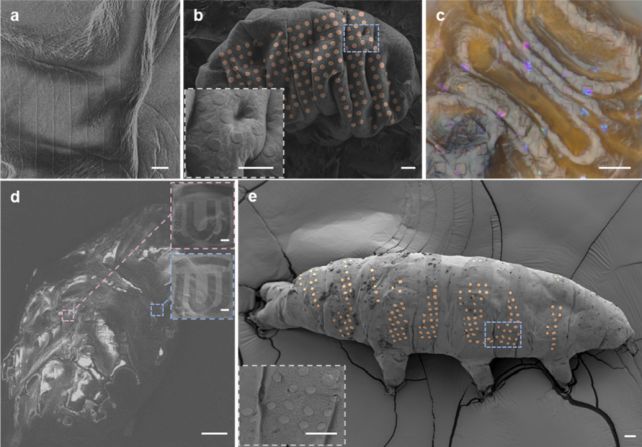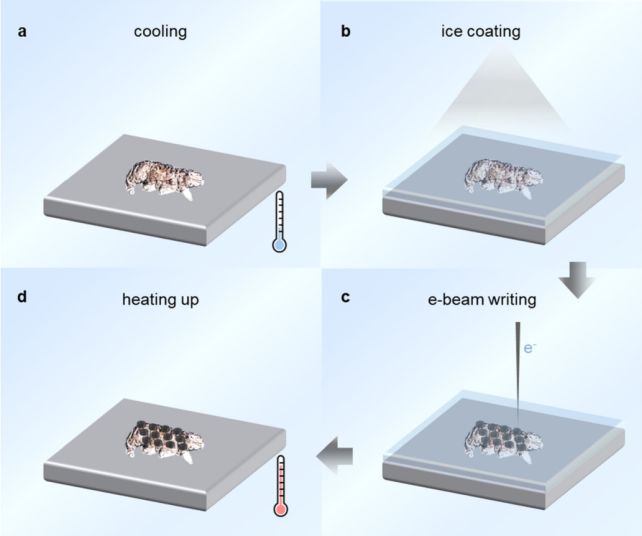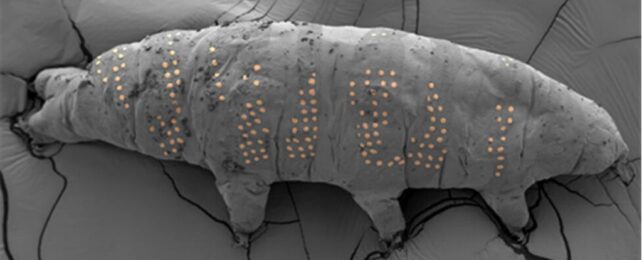A new technique has allowed researchers to tattoo patterns onto the tiny bodies of living tardigrades.
The aim wasn't to make the microscopic animals even cooler than they already are, if that is possible. Rather, it could help scientists make teeny-tiny biocompatible devices, such as sensors, integrated circuits, and even nanoscale living robots.
Plus, the process sheds light on tardigrades' remarkable resilience: some, but not all, of the critters survived the experience, to waddle around all tatted up like tiny badasses.
"Through this technology, we're not just creating micro-tattoos on tardigrades," explains optical engineer Ding Zhao of the Technical University of Denmark, "we're extending this capability to various living organisms, including bacteria."

The ability to etch patterns onto tiny objects and surfaces is an important part of the development of nanotechnology. Great strides have been made in translating existing technologies to the nanoscale for material engineering, but putting high-resolution patterns on itty-bitty living organisms remains a bit of a challenge.
To tattoo a tardigrade, Zhao and his colleagues adapted a nanofabrication technique called ice lithography. This is a form of electron-beam lithography, in which a beam of electrons is fired at a target to etch a nanoscale pattern onto a surface.
On surfaces with very fine patterns, bare electron-beam lithography can introduce contamination or damage. Scientists figured out that putting a very thin layer of ice between the beam and the surface prevented this, allowing for etching down to scales smaller than 20 nanometers.
The average human hair, for context, is about 80,000 to 100,000 nanometers wide. Tardigrades are up to around 500,000 nanometers.
Tardigrades are famed for their near-indestructibility, and part of that has to do with their 'tun' state. When environmental conditions become untenable, the tardigrade dehydrates its body and enters a state of suspended metabolism called cryptobiosis, to revive when things return to normal. A tardigrade in a tun can survive extreme conditions, including freezing and boiling.

Zhao's team started by inducing this state of cryptobiosis in their tardigrades, after which they were stored until it was their turn under the electron beam.
Only one tardigrade was processed at a time, to reduce their exposure to the experimental conditions. Each tardigrade was placed on a sheet of carbon-composite paper in a vacuum chamber, which was then cooled to a temperature of -143 degrees Celsius (-226 Fahrenheit).
A layer of anisole (a colorless liquid compound that smells like anise) was applied over the cooled tardigrade to serve as the ice protecting it from the electron beam. Where the beam fired, the anisole reacted, forming a new compound that stuck to the skin of the tardigrade.
When the tardigrade warmed up in the vacuum chamber, the finely inscribed pattern remained, with details as small as 72 nanometers. Then, the scientists removed each tardigrade, rehydrated it, and attempted revival.
Forty percent of the tardigrades survived the procedure and were able to move around as normal, sporting their new tattoos. The markings stayed in place even after being exposed to conditions such as stretching, soaking, rinsing, and drying.
"This study successfully demonstrates in situ fabrication of micro/nanopatterns on living organisms using ice lithography," the researchers write in their paper.
Now, tardigrades are better able than most organisms to survive whatever hardships are thrown at them; other lifeforms may not be able to withstand the process. However, the research is just a first step. Now that the scientists know that it's possible, they can tweak their technique to try to increase the survival rate.
"In addition to tardigrades, our approach may also be applicable to other organisms with high stress resistance or those suitable for cryopreservation," the team concludes.
"We anticipate that the integration of more micro/nanofabrication techniques with biologically relevant systems at the micro/nanoscale will further advance fields such as microbial sensing, biomimetic devices, and living microrobots."
The research has been published in Nano Letters.
